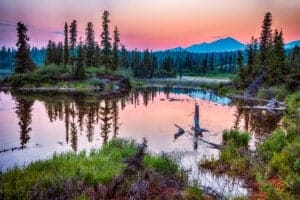Discover the 7 Best National Parks in South Carolina
@media (min-width: 481px) {
.mobile-top-content {
display: none;
}
}
#mobileTopContentCTACarouselControls { overflow: hidden; text-overflow: ellipsis; white-space: nowrap; }
.mobile-top-content .more { color: #fff; }
.mobile-top-content a { color: #fff; text-decoration: underline; }
.mobile-top-content a:hover { color: #fff; text-decoration: underline; }
@media (max-width: 480px) {
.mobile-top-content {
background-color: #06a10b;
color: #fff;
text-align: center;
/*height: 60px;
padding-top:5px;*/
font-size:80%;
/* display: block; */
margin: 0px -30px;
}
}
Thanks to its warm climate, welcoming hospitality, low cost of living, and other amazing perks, South Carolina is an excellent state to live in. However, the state provides much more with its beautiful natural spectacles, including its seven fascinating national parks.
These parks attract approximately 1.6 million visitors each year. Through tourism, these visitors generate about $93.5 million in revenue.
In this article, we’ll look at these national parks, making sure to cover key areas, especially for those who’d like to consider them for their next adventure.
1. Charles Pinckney National Historic Site
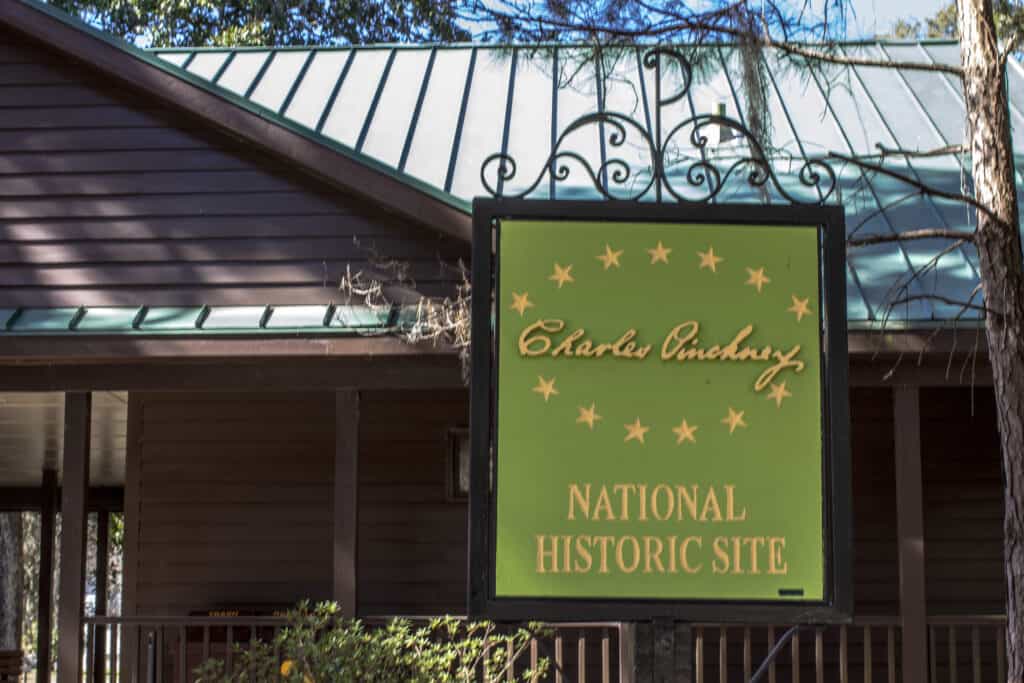
iStock.com/ehrlif
| Charles Pinckney National Historic Site | |
|---|---|
| Size | 28 acres |
| Animals to see | Pigs, bees |
| Attraction to see | Boone Hall Plantation |
Charles Pinckney National Historic Site is about six miles northeast of Charleston in eastern South Carolina. The park is open throughout the year, and Charles Pinckney’s Snee Farm tours are available.
Charles Pinckney is most recognized for his role in the 1878 signing of the United States Constitution. He also played a role in the creation of this important document, so much that “Constitution Charlie” was his moniker.
His father bequeathed him Snee Farm, a 715-acre estate. In 1791, the farm served breakfast to George Washington, but unfortunately, Pinckney had to sell the farm due to outstanding debts, and therefore the original house was dismantled.
The National Park Service now manages a 28-acre piece of what was once Snee Farms. The tourist center is housed in a mansion erected after Charles Pinckney’s death in 1828.
A Lowcountry seaside cottage from 1828 serves as the museum and visitor center. Ornamental gardens with Spanish moss, live oak, and canopies may be found on park grounds. There is a lot to see and do, such as archeological displays, exhibitions, and documentaries. You can walk around the grounds, pack a picnic, or go on a nature trail to stretch your legs. Learn about a founding father while taking in the sights and sounds of his beautiful country residence.
2. Congaree National Park
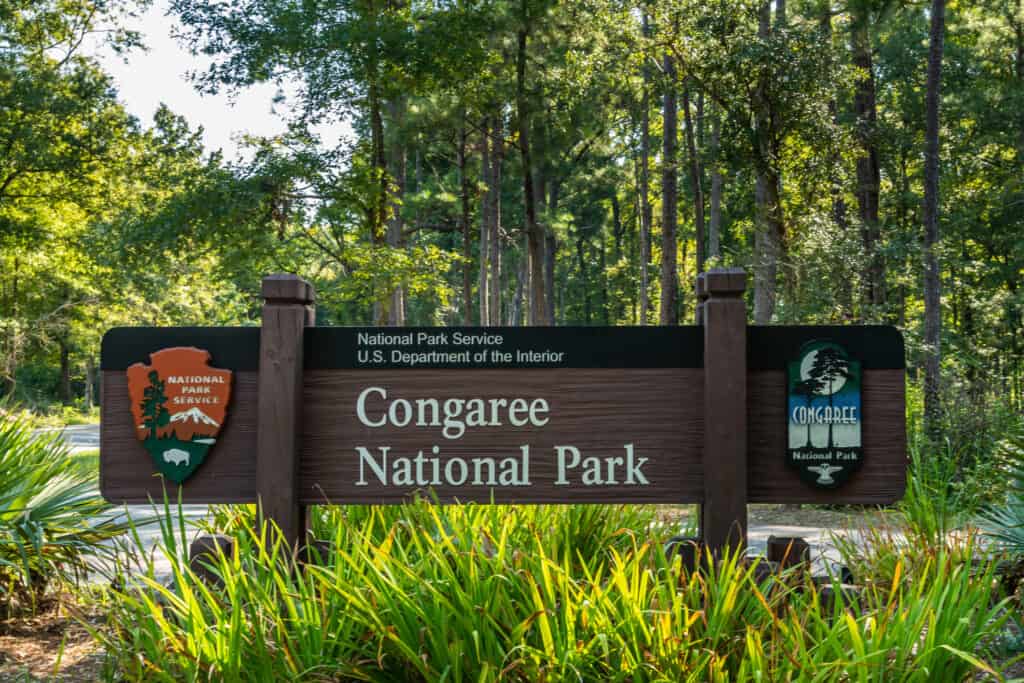
iStock.com/kellyvandellen
| Congaree National Park | |
|---|---|
| Size | 26,276 acres |
| Animals to see | Opossums, foxes, bobcats, deer, river otters, wild pigs |
| Attraction to see | Harry Hampton Visitor Center, The Boardwalk Trail |
Congaree National Park is about 20 miles southeast of Columbia, South Carolina, in central South Carolina. The park is open all year and allows visitors to walk along boardwalks through the biggest intact tract of old-growth bottomland hardwood forest in the southern United States.
The park was formerly known as the Congaree Swamp National Monument, but once it became a national park in 2003, the name “swamp” was dropped because the area is a floodplain rather than a swamp.
The Harry Hampton Visitor Center is an excellent site to begin your park visit. Depending on the time of year, the boardwalk may be sealed because of flooding. The Boardwalk Trail loops through the park and features 2.4 miles of elevated, wheelchair-accessible boardwalks.
As you travel along the boardwalk, you’ll notice tupelo, oak, bald cypress, and Loblolly pine trees. Congaree National Park is home to one of the country’s most extensive collections of champion trees, the largest species of their kind.
3. Cowpens National Battlefield
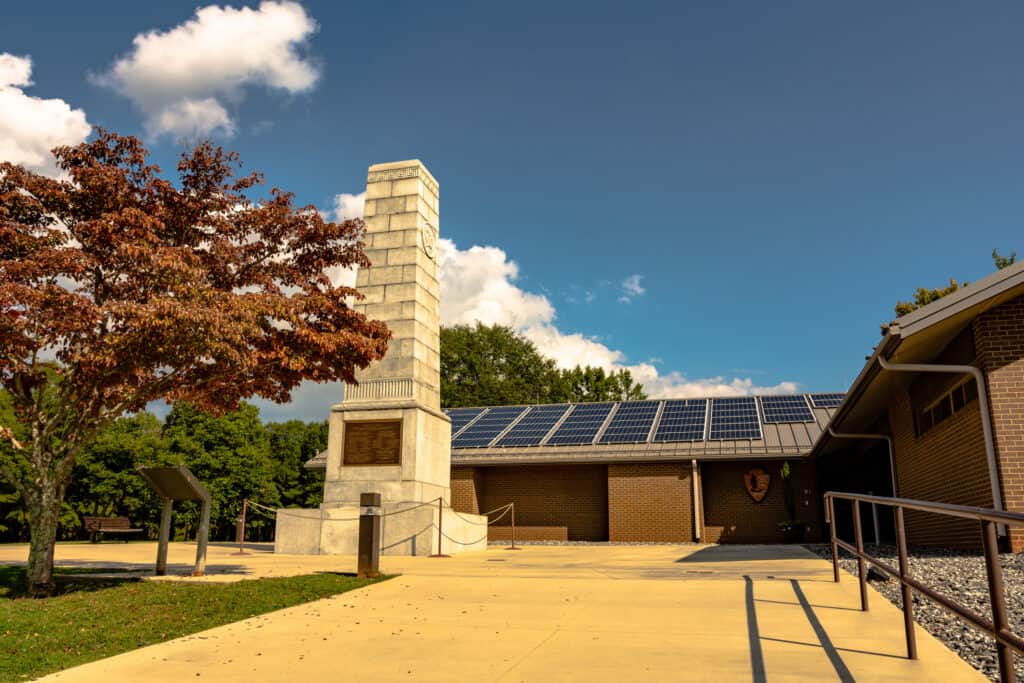
iStock.com/Jacqueline Nix
| Cowpens National Battlefield | |
|---|---|
| Size | 842 acres |
| Animals to see | White-tail deer, turtles, salamanders, cotton-tail rabbits, turkeys, frogs |
| Attraction to see | The battlefield |
Cowpens National Battlefield is about 15 miles northeast of Spartanburg in north-central South Carolina. The park has a park film, a visitor center, a 3.8-mile driving tour, and a 1.2-mile battlefield trail that is available all year.
South Carolina saw more engagements and clashes during the Revolutionary War than any other state in the United States. British troops headed by Lieutenant Colonel Banastre Tarleton attacked Patriot soldiers led by Gen. Daniel Morgan on January 17, 1781. Although the battle only lasted an hour, it significantly impacted the Revolutionary War’s outcome. The Patriot General Morgan held off the opening onslaught from the more experienced British forces and swept around both flanks. In less than 60 minutes, the Patriots cruised to victory, which boosted their morale and laid the stage for the British capitulation at Yorktown.
The tourist center at the national battlefield site includes a museum. Exhibits relevant to the history of the place during the American Revolutionary War can be found across the whole museum. There are also guided tours available to the historic battleground.
4. Fort Sumter And Fort Moultrie National Historical Park
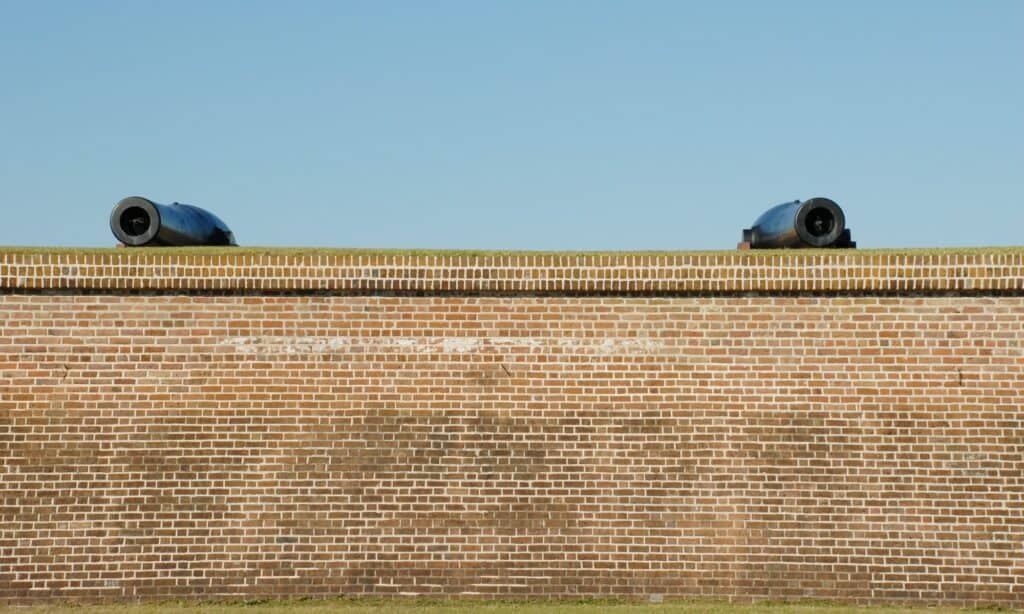
iStock.com/visionsofmaine
| Fort Sumter And Fort Moultrie National Historical Park | |
|---|---|
| Size | 199.57 acres |
| Animals to see | Laughing Gulls, pelicans, dolphins |
| Attraction to see | Fort Moultrie, Fort Sumter |
The National Historical Park of Fort Sumter and Fort Moultrie is located near Charleston Harbor in southeastern South Carolina. The park is open all year and allows visitors to view two ancient forts as well as the park’s visitor centers.
This national monument is a sea fort that saw two major fights during the American Civil War. Fort Moultrie, the visitor learning center, and Fort Sumter are all part of the complex. The only way to get to Fort Sumter is to rent a charter boat. You can also take a boat ride that takes around 30 minutes and departs from Patriots Point or the learning center.
Tourists who want to learn more about the fort’s history and importance during the American Civil War flock to the visitor center. You’ll learn about the building’s history as well. It first opened its doors to the public in 1948 as one of the national park service’s South Carolina units.
Board a ferry to Fort Sumter and tour the modern concrete gun battery, completed in 1898. The flag-raising and lowering ceremonies are also spectacular if you can make it to the first or last trip.
5. National Military Park

iStock.com/zrfphoto
| National Military Park | |
|---|---|
| Size | 3,945 acres |
| Animals to see | Whitetail deer, frogs |
| Attraction to see | Patrick Ferguson’s Grave, Battlefield trail |
The Kings Mountain National Monument is 35 miles southwest of Charlotte in north-central South Carolina. The park is open all year and includes a 1.5-mile self-guided walking track, a visitor center, and a close-up view of the battleground.
You may learn about hour-long combat that changed the trajectory of the Revolutionary War at the park. You can start your journey at the visitor’s center, where you’ll be presented with a 26-minute film about the battle and its significance in history.
There’s also an exposition section to learn more about why the combat occurred and how the conclusion influenced the war’s outcome. When you’ve had your fill of indoor history, there’s a 1.5-mile battlefield trail to walk on. It’s a lovely path that runs alongside the battlefield. You’ll pass many markers for key characters from the conflict along the way.
6. Ninety-Six National Historic Site

iStock.com/zrfphoto
| Ninety-Six National Historic Site | |
|---|---|
| Size | 1,022 acres |
| Animals to see | Beavers, raccoons, squirrels, shrews, foxes |
| Attraction to see | Ruins of Star Fort |
Ninety-Six National Historic Site is situated 60 miles west of Columbia in west-central South Carolina. The park is open all year and features a one-mile interpretative loop that takes visitors past the historic star fort.
Due to border highways passing through this area in the early 18th century, it was a prosperous town. The settlement was once thought to be 96 miles from the Cherokee community of Keowee, but this was not the case.
A modest museum is housed in a visitor center. It includes artifacts discovered on the site as well as items from the period. Paintings commemorating battles and local leaders from the American Revolution are also on display. A short film describing the conflict is shown to visitors. You can rent an audio tour guide for the park. A gift shop is also available.
Take a one-mile educational walk from the visitor center to the ruins of Star Fort and the original location of Ninety-Six while you’re there. You can tour the interpretative loop, visit the small visitor center, and witness one of the least affected environments of any Revolutionary War battlefield.
7. Reconstruction Era National Historical Park
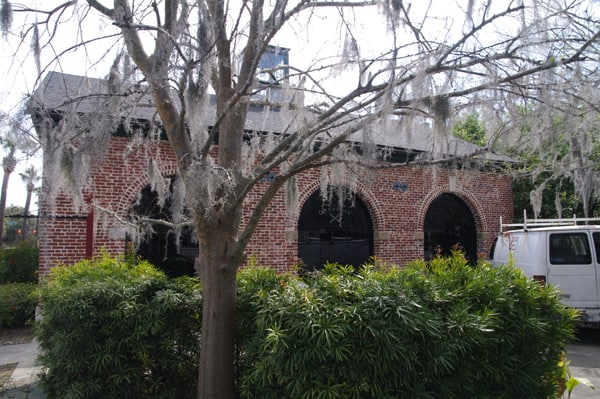
TheDigitel Beaufort from Beaufort, SC, USA / Creative Commons – License
| Reconstruction Era National Historical Park | |
|---|---|
| Size | 64.99 acres |
| Animal to see | – |
| Attraction to see | Penn Center |
The Reconstruction Era National Historical Park is a work-in-progress in Beaufort County, South Carolina. The park opened in January of 2017. The National Park Service is presently developing the park program.
The park visitor center in Beaufort is an excellent place to begin your trip. You can also pay a visit to the Penn Center. The Beaufort History Museum is not part of the park, but it has a lot of information about the Reconstruction Era.
The Reconstruction Era spans 1861 to 1898. The period during which the United States tried to introduce millions of formerly enslaved people into the social, political, economic, and labor institutions.
More from A-Z Animals
.more-snake-card-image { max-height:140px !important; }
@media (min-width: 481px) {
.mobile-top-content {
display: none;
}
}
#mobileTopContentCTACarouselControls { overflow: hidden; text-overflow: ellipsis; white-space: nowrap; }
.mobile-top-content .more { color: #fff; }
.mobile-top-content a { color: #fff; text-decoration: underline; }
.mobile-top-content a:hover { color: #fff; text-decoration: underline; }
@media (max-width: 480px) {
.mobile-top-content {
background-color: #06a10b;
color: #fff;
text-align: center;
/*height: 60px;
padding-top:5px;*/
font-size:80%;
/* display: block; */
margin: 0px -30px;
}
}
Thanks to its warm climate, welcoming hospitality, low cost of living, and other amazing perks, South Carolina is an excellent state to live in. However, the state provides much more with its beautiful natural spectacles, including its seven fascinating national parks.
These parks attract approximately 1.6 million visitors each year. Through tourism, these visitors generate about $93.5 million in revenue.
In this article, we’ll look at these national parks, making sure to cover key areas, especially for those who’d like to consider them for their next adventure.
1. Charles Pinckney National Historic Site

iStock.com/ehrlif
| Charles Pinckney National Historic Site | |
|---|---|
| Size | 28 acres |
| Animals to see | Pigs, bees |
| Attraction to see | Boone Hall Plantation |
Charles Pinckney National Historic Site is about six miles northeast of Charleston in eastern South Carolina. The park is open throughout the year, and Charles Pinckney’s Snee Farm tours are available.
Charles Pinckney is most recognized for his role in the 1878 signing of the United States Constitution. He also played a role in the creation of this important document, so much that “Constitution Charlie” was his moniker.
His father bequeathed him Snee Farm, a 715-acre estate. In 1791, the farm served breakfast to George Washington, but unfortunately, Pinckney had to sell the farm due to outstanding debts, and therefore the original house was dismantled.
The National Park Service now manages a 28-acre piece of what was once Snee Farms. The tourist center is housed in a mansion erected after Charles Pinckney’s death in 1828.
A Lowcountry seaside cottage from 1828 serves as the museum and visitor center. Ornamental gardens with Spanish moss, live oak, and canopies may be found on park grounds. There is a lot to see and do, such as archeological displays, exhibitions, and documentaries. You can walk around the grounds, pack a picnic, or go on a nature trail to stretch your legs. Learn about a founding father while taking in the sights and sounds of his beautiful country residence.
2. Congaree National Park

iStock.com/kellyvandellen
| Congaree National Park | |
|---|---|
| Size | 26,276 acres |
| Animals to see | Opossums, foxes, bobcats, deer, river otters, wild pigs |
| Attraction to see | Harry Hampton Visitor Center, The Boardwalk Trail |
Congaree National Park is about 20 miles southeast of Columbia, South Carolina, in central South Carolina. The park is open all year and allows visitors to walk along boardwalks through the biggest intact tract of old-growth bottomland hardwood forest in the southern United States.
The park was formerly known as the Congaree Swamp National Monument, but once it became a national park in 2003, the name “swamp” was dropped because the area is a floodplain rather than a swamp.
The Harry Hampton Visitor Center is an excellent site to begin your park visit. Depending on the time of year, the boardwalk may be sealed because of flooding. The Boardwalk Trail loops through the park and features 2.4 miles of elevated, wheelchair-accessible boardwalks.
As you travel along the boardwalk, you’ll notice tupelo, oak, bald cypress, and Loblolly pine trees. Congaree National Park is home to one of the country’s most extensive collections of champion trees, the largest species of their kind.
3. Cowpens National Battlefield

iStock.com/Jacqueline Nix
| Cowpens National Battlefield | |
|---|---|
| Size | 842 acres |
| Animals to see | White-tail deer, turtles, salamanders, cotton-tail rabbits, turkeys, frogs |
| Attraction to see | The battlefield |
Cowpens National Battlefield is about 15 miles northeast of Spartanburg in north-central South Carolina. The park has a park film, a visitor center, a 3.8-mile driving tour, and a 1.2-mile battlefield trail that is available all year.
South Carolina saw more engagements and clashes during the Revolutionary War than any other state in the United States. British troops headed by Lieutenant Colonel Banastre Tarleton attacked Patriot soldiers led by Gen. Daniel Morgan on January 17, 1781. Although the battle only lasted an hour, it significantly impacted the Revolutionary War’s outcome. The Patriot General Morgan held off the opening onslaught from the more experienced British forces and swept around both flanks. In less than 60 minutes, the Patriots cruised to victory, which boosted their morale and laid the stage for the British capitulation at Yorktown.
The tourist center at the national battlefield site includes a museum. Exhibits relevant to the history of the place during the American Revolutionary War can be found across the whole museum. There are also guided tours available to the historic battleground.
4. Fort Sumter And Fort Moultrie National Historical Park

iStock.com/visionsofmaine
| Fort Sumter And Fort Moultrie National Historical Park | |
|---|---|
| Size | 199.57 acres |
| Animals to see | Laughing Gulls, pelicans, dolphins |
| Attraction to see | Fort Moultrie, Fort Sumter |
The National Historical Park of Fort Sumter and Fort Moultrie is located near Charleston Harbor in southeastern South Carolina. The park is open all year and allows visitors to view two ancient forts as well as the park’s visitor centers.
This national monument is a sea fort that saw two major fights during the American Civil War. Fort Moultrie, the visitor learning center, and Fort Sumter are all part of the complex. The only way to get to Fort Sumter is to rent a charter boat. You can also take a boat ride that takes around 30 minutes and departs from Patriots Point or the learning center.
Tourists who want to learn more about the fort’s history and importance during the American Civil War flock to the visitor center. You’ll learn about the building’s history as well. It first opened its doors to the public in 1948 as one of the national park service’s South Carolina units.
Board a ferry to Fort Sumter and tour the modern concrete gun battery, completed in 1898. The flag-raising and lowering ceremonies are also spectacular if you can make it to the first or last trip.
5. National Military Park

iStock.com/zrfphoto
| National Military Park | |
|---|---|
| Size | 3,945 acres |
| Animals to see | Whitetail deer, frogs |
| Attraction to see | Patrick Ferguson’s Grave, Battlefield trail |
The Kings Mountain National Monument is 35 miles southwest of Charlotte in north-central South Carolina. The park is open all year and includes a 1.5-mile self-guided walking track, a visitor center, and a close-up view of the battleground.
You may learn about hour-long combat that changed the trajectory of the Revolutionary War at the park. You can start your journey at the visitor’s center, where you’ll be presented with a 26-minute film about the battle and its significance in history.
There’s also an exposition section to learn more about why the combat occurred and how the conclusion influenced the war’s outcome. When you’ve had your fill of indoor history, there’s a 1.5-mile battlefield trail to walk on. It’s a lovely path that runs alongside the battlefield. You’ll pass many markers for key characters from the conflict along the way.
6. Ninety-Six National Historic Site

iStock.com/zrfphoto
| Ninety-Six National Historic Site | |
|---|---|
| Size | 1,022 acres |
| Animals to see | Beavers, raccoons, squirrels, shrews, foxes |
| Attraction to see | Ruins of Star Fort |
Ninety-Six National Historic Site is situated 60 miles west of Columbia in west-central South Carolina. The park is open all year and features a one-mile interpretative loop that takes visitors past the historic star fort.
Due to border highways passing through this area in the early 18th century, it was a prosperous town. The settlement was once thought to be 96 miles from the Cherokee community of Keowee, but this was not the case.
A modest museum is housed in a visitor center. It includes artifacts discovered on the site as well as items from the period. Paintings commemorating battles and local leaders from the American Revolution are also on display. A short film describing the conflict is shown to visitors. You can rent an audio tour guide for the park. A gift shop is also available.
Take a one-mile educational walk from the visitor center to the ruins of Star Fort and the original location of Ninety-Six while you’re there. You can tour the interpretative loop, visit the small visitor center, and witness one of the least affected environments of any Revolutionary War battlefield.
7. Reconstruction Era National Historical Park

TheDigitel Beaufort from Beaufort, SC, USA / Creative Commons – License
| Reconstruction Era National Historical Park | |
|---|---|
| Size | 64.99 acres |
| Animal to see | – |
| Attraction to see | Penn Center |
The Reconstruction Era National Historical Park is a work-in-progress in Beaufort County, South Carolina. The park opened in January of 2017. The National Park Service is presently developing the park program.
The park visitor center in Beaufort is an excellent place to begin your trip. You can also pay a visit to the Penn Center. The Beaufort History Museum is not part of the park, but it has a lot of information about the Reconstruction Era.
The Reconstruction Era spans 1861 to 1898. The period during which the United States tried to introduce millions of formerly enslaved people into the social, political, economic, and labor institutions.






